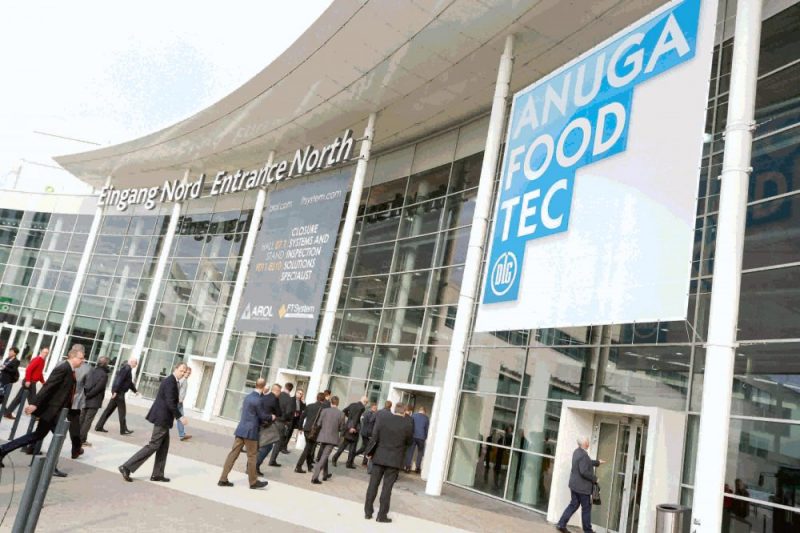Final countdown for key Anuga Foodtec show

Eingang Nord
Managing industry resources in terms of production sustainability is set for the core theme of this year’s Anuga Foodtec taking place in Cologne, Germany.
The event, which starts next week from 20 to 23 March holds answers in store for visitors, with upcycling strategies and innovative methods for the recovery of materials from industrial by-products also high on the agenda.
Added value gained from waste products holds enormous potential for food manufacturers, including the confectionery and bakery sectors, which will be addressed during this key industry showcase staged every three years.
While on the one hand, the upcycling of by-products that arise in partly large volumes while processing vegetable and animal-based raw materials is resource-friendly and ecological.
Conversely, the biomass contains a multitude of substances that can be implemented as ingredients for new foodstuffs. Modern machinery and innovative methods for the recovery and upgrading of by-products are of particular interest here.
The initial starting point of every upcycling strategy is always the homogeneous separation of the arising vegetable and animal-based secondary raw materials.
Whey is a prime example of successful upcycling. The former waste product that arises in large volumes during the production of curd cheese and cheese is turned into coveted “superfoods” that no longer just create added value in fitness studios. Thanks to its protein, vitamin and mineral content, the popular ingredient is in the meantime added to puddings, drinks and smoothies – and it is also implemented as a demineralised concentrate in baby food.
Numerous exhibitors at Anuga FoodTec will be presenting established technologies for the isolation of whey components and for the further processing of the recovered ingredients into liquid, as well as powder products.
Separating methods isolate the valuable components
The membrane separation method plays a key role, especially ultrafiltration. It allows the whey protein to be concentrated by up to 35%. In protein isolates up to 90 percent, the whey is freed from the fat by means of microfiltration. Lactose and minerals like calcium and phosphorus can be recovered from the permeate flow of the protein isolation by means of nanofiltration or reverse osmosis. In this way, by cleverly combining dynamic filtration methods enriched products can be produced that contain the high-quality components in the desired concentration.
In addition to the membrane filtration method, the separator technology has also established itself as a further upcycling method. Among others its strengths lie in lecithin, which occurs as a by-product when soya beans, sunflower seeds and rape seeds are processed. The lipids are highly appreciated in the food industry as a natural alternative to synthetic emulsifiers and stabilisers. High-speed separators that separate the lecithin and raw oil have to be implemented to recover lecithin.
New ingredients from residues
Thanks to upcycling the offer of natural food additives is becoming more comprehensive, as one can see from the example of pectin. The by-product that is generated during the production of apple juice is used as a gelling agent, which is in the meantime indispensable within the food industry. Polyphenols that are found in the pressing residues are in future to be used to add a further brown shade to the palette of natural colourants for food.
The aim of a project supported by the Federal Ministry for Economic Affairs and Energy is to develop a large-scale technical process that uses the waste products left over after making juices as an alternative for caramel colouring. As part of the key outlook for the envent, it will demonstrate that like recycling, upcycling – the transformation of industrial by-products into important substances – has firmly established itself in the industrial environment of food production. The machines presented at the Cologne event can already be integrated into all common processes. Rising prices for raw materials and a worldwide growing ecological awareness demand the friendly and efficient handling of natural resources. Titled “Resource efficiency – challenges and opportunities” the opening session takes place at the Cologne fair grounds on 20 March, and picks up on these aspects.
Natural Products
Naturalness has become the decisive buying factor on the supermarket shelves – a trend that is reflected in the growing demand for natural aromas, colouring foodstuffs, health and nutrition ingredients.
The event will show which options there are today for granulating, coating, encapsulating, agglomerating and instantising. Anuga FoodTec is dedicating an own product segment to food ingredients, the main focus of which will be found on the Boulevard of the trade fair.
– The Confectionery Production team will be covering the event, so please get in touch with your news and views, to myself, editor, Neill Barston, at [email protected] and for more event details visit www.anugafoodtec.com



